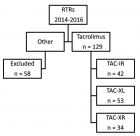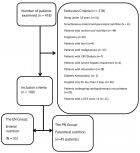Abstract
Mini Review
Forest History Association of Wisconsin
Ed Bauer*
Published: 30 October, 2024 | Volume 8 - Issue 3 | Pages: 093-096
The Enterprise Radiation Forest (ERF) study was initially introduced as a topic of discussion at the Institute of Forest Genetics, USDA, USFS, in the late 1960s. During that period, a program was endorsed for investigating the impacts of radiation on the forest ecosystem. The rationale for this was to facilitate the prediction of potential outcomes in the occurrence of a nuclear disaster. The research location was situated within the forested lands in Enterprise of Oneida County, Wisconsin, United States. The radiation source in question was a 10,000 curie source of Cesium-137, characterized by a halflife of 33 years. Furthermore, a study concerning lichens was also carried out, the data, photographs, and micrographs were meticulously gathered to illustrate the pre-irradiation activity of the species. This subject holds significant value for dissemination among peers in the scientific community, particularly considering the resilience exhibited by natural ecosystems in response to varying levels of radiation. The information is reviewed with the objective of the entire program to ascertain the potential consequences for a northern forest ecosystem in the event of a nuclear disaster, in addition to the two publications from the Atomic Energy Commission.
Read Full Article HTML DOI: 10.29328/journal.jro.1001071 Cite this Article Read Full Article PDF
Keywords:
Radiation impacts; Forest ecosystem; Pre-irradiation activity; Lichens; Nuclear disaster
References
- Rudolph TD. The Enterprise, Wisconsin, Radiation Forest: preirradiation ecological studies. 1974. Available from: https://doi.org/10.5962/bhl.title.149776
- Zavitkovski J. The Enterprise, Wisconsin, Radiation Forest: radioecological studies. Prepared for the Division of Biomedical and Environmental Research, Energy Research and Development Administration. Oak Ridge, TN: Technical Information Center, Energy Research and Development Administration; 1977. Available from: https://archive.org/details/enterprisewiscon0000unse
- Bjerregaard P, Andersen CBI, Andersen O. Ecotoxicology of metals-sources, transport, and effects on the ecosystem. In: Elsevier eBooks. 2022. p. 593-627. Available from: https://doi.org/10.1016/b978-0-12-823292-7.00016-4
Figures:

Figure 1

Figure 2

Figure 3

Figure 4

Figure 5

Figure 6

Figure 7

Figure 8

Figure 9

Figure 10
Similar Articles
-
Forest History Association of WisconsinEd Bauer*. Forest History Association of Wisconsin. . 2024 doi: 10.29328/journal.jro.1001071; 8: 093-096
Recently Viewed
-
Biotechnology in Forensic Science: Advancements and ApplicationsSunny Antil,Vandana Joon*. Biotechnology in Forensic Science: Advancements and Applications. J Forensic Sci Res. 2025: doi: 10.29328/journal.jfsr.1001073; 9: 007-014
-
Sinonasal Myxoma Extending into the Orbit in a 4-Year Old: A Case PresentationJulian A Purrinos*, Ramzi Younis. Sinonasal Myxoma Extending into the Orbit in a 4-Year Old: A Case Presentation. Arch Case Rep. 2024: doi: 10.29328/journal.acr.1001099; 8: 075-077
-
The Need of Wider and Deeper Skin Biopsy in Verrucous Carcinoma of the SoleLuca Damiani*,Giuseppe Argenziano,Andrea Ronchi,Francesca Pagliuca,Emma Carraturo,Vincenzo Piccolo,Gabriella Brancaccio. The Need of Wider and Deeper Skin Biopsy in Verrucous Carcinoma of the Sole. Ann Dermatol Res. 2025: doi: 10.29328/journal.adr.1001036; 9: 005-007
-
RBD targeted COVID vaccine and full length spike-protein vaccine (mutation and glycosylation role) relationship with procoagulant effectLuisetto M*,Tarro G,Farhan Ahmad Khan,Khaled Edbey,Mashori GR,Yesvi AR,Latyschev OY. RBD targeted COVID vaccine and full length spike-protein vaccine (mutation and glycosylation role) relationship with procoagulant effect. J Child Adult Vaccines Immunol. 2021: doi: 10.29328/journal.jcavi.1001007; 5: 001-008
-
The Death of a Baby from the Congenital Anomalies of the Urinary TractAstrit Gashi M*,Gent Sopa,Ilir Kadiri,Majlinda Bala,Petrit Pupa. The Death of a Baby from the Congenital Anomalies of the Urinary Tract. J Clin Med Exp Images. 2018: doi: 10.29328/journal.jcmei.1001009; 2: 001-002
Most Viewed
-
Evaluation of Biostimulants Based on Recovered Protein Hydrolysates from Animal By-products as Plant Growth EnhancersH Pérez-Aguilar*, M Lacruz-Asaro, F Arán-Ais. Evaluation of Biostimulants Based on Recovered Protein Hydrolysates from Animal By-products as Plant Growth Enhancers. J Plant Sci Phytopathol. 2023 doi: 10.29328/journal.jpsp.1001104; 7: 042-047
-
Sinonasal Myxoma Extending into the Orbit in a 4-Year Old: A Case PresentationJulian A Purrinos*, Ramzi Younis. Sinonasal Myxoma Extending into the Orbit in a 4-Year Old: A Case Presentation. Arch Case Rep. 2024 doi: 10.29328/journal.acr.1001099; 8: 075-077
-
Feasibility study of magnetic sensing for detecting single-neuron action potentialsDenis Tonini,Kai Wu,Renata Saha,Jian-Ping Wang*. Feasibility study of magnetic sensing for detecting single-neuron action potentials. Ann Biomed Sci Eng. 2022 doi: 10.29328/journal.abse.1001018; 6: 019-029
-
Pediatric Dysgerminoma: Unveiling a Rare Ovarian TumorFaten Limaiem*, Khalil Saffar, Ahmed Halouani. Pediatric Dysgerminoma: Unveiling a Rare Ovarian Tumor. Arch Case Rep. 2024 doi: 10.29328/journal.acr.1001087; 8: 010-013
-
Physical activity can change the physiological and psychological circumstances during COVID-19 pandemic: A narrative reviewKhashayar Maroufi*. Physical activity can change the physiological and psychological circumstances during COVID-19 pandemic: A narrative review. J Sports Med Ther. 2021 doi: 10.29328/journal.jsmt.1001051; 6: 001-007

HSPI: We're glad you're here. Please click "create a new Query" if you are a new visitor to our website and need further information from us.
If you are already a member of our network and need to keep track of any developments regarding a question you have already submitted, click "take me to my Query."




















































































































































